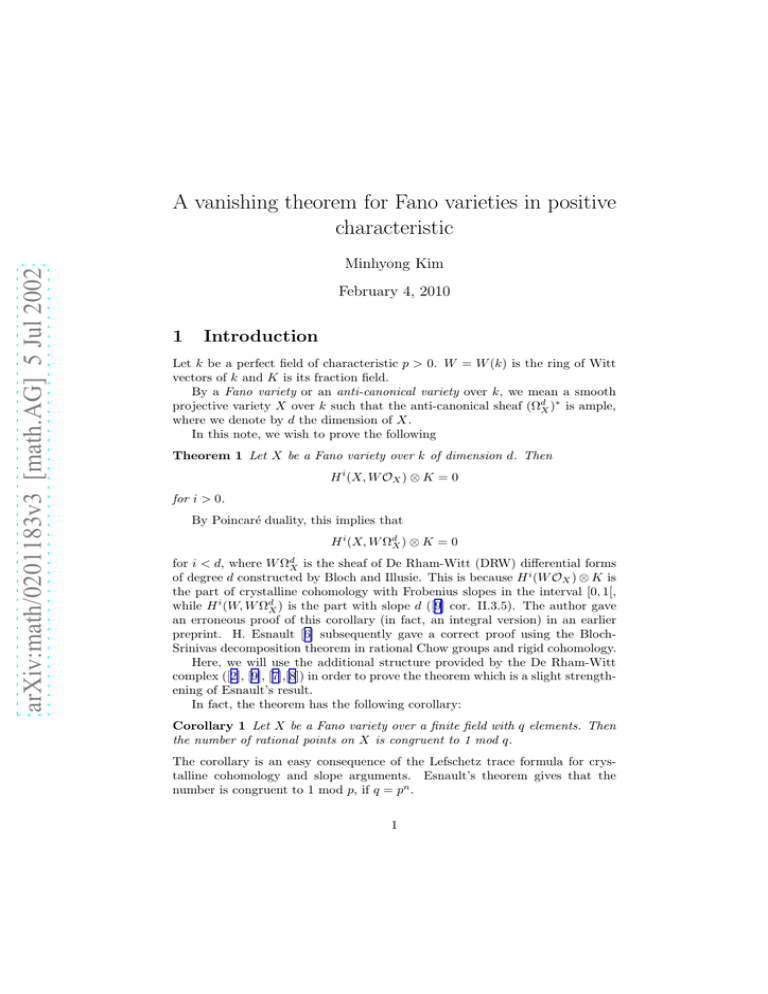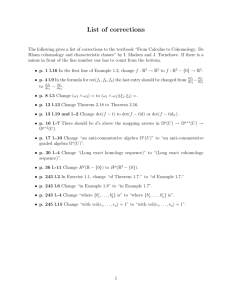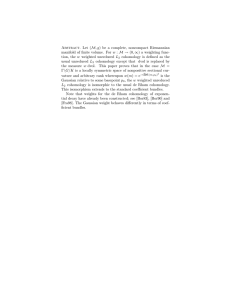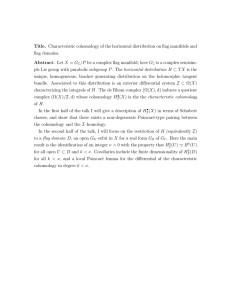A vanishing theorem for Fano varieties in positive characteristic 1 Introduction
advertisement

arXiv:math/0201183v3 [math.AG] 5 Jul 2002 A vanishing theorem for Fano varieties in positive characteristic Minhyong Kim February 4, 2010 1 Introduction Let k be a perfect field of characteristic p > 0. W = W (k) is the ring of Witt vectors of k and K is its fraction field. By a Fano variety or an anti-canonical variety over k, we mean a smooth projective variety X over k such that the anti-canonical sheaf (ΩdX )∗ is ample, where we denote by d the dimension of X. In this note, we wish to prove the following Theorem 1 Let X be a Fano variety over k of dimension d. Then H i (X, W OX ) ⊗ K = 0 for i > 0. By Poincaré duality, this implies that H i (X, W ΩdX ) ⊗ K = 0 for i < d, where W ΩdX is the sheaf of De Rham-Witt (DRW) differential forms of degree d constructed by Bloch and Illusie. This is because H i (W OX ) ⊗ K is the part of crystalline cohomology with Frobenius slopes in the interval [0, 1[, while H i (W, W ΩdX ) is the part with slope d ([9] cor. II.3.5). The author gave an erroneous proof of this corollary (in fact, an integral version) in an earlier preprint. H. Esnault [6] subsequently gave a correct proof using the BlochSrinivas decomposition theorem in rational Chow groups and rigid cohomology. Here, we will use the additional structure provided by the De Rham-Witt complex ([2], [9], [7],[8]) in order to prove the theorem which is a slight strengthening of Esnault’s result. In fact, the theorem has the following corollary: Corollary 1 Let X be a Fano variety over a finite field with q elements. Then the number of rational points on X is congruent to 1 mod q. The corollary is an easy consequence of the Lefschetz trace formula for crystalline cohomology and slope arguments. Esnault’s theorem gives that the number is congruent to 1 mod p, if q = pn . 1 2 Proof Throughout, if we write H i without further embellishments, we mean rational crystalline cohomology. We start with a quick summary of Esnault’s proof (which was an adaptation of Bloch’s proof in characteristic zero [3]): Because X is rationally connected and therefore CH0 (X) ⊗ Q = 0 ([10]), one gets from the Bloch-Srinivas theorem [4] that the diagonal correspondence ∆ ⊂ X × X is equivalent in CH0 (X) ⊗ Q to a sum z×X +Z where z is the class of a closed point and Z is a cycle supported on X × U for U ⊂ X the complement of a divisor D ⊂ X. Therefore, if we apply the diagonal correspondence to a class of H i (X), i > 0, then the only thing that acts is the Z part. That is, if i > 0, and α ∈ H i (X) then [∆]∗ (α) = [Z]∗ (α). We have i (X) H i (X) ≃ Hrig i where Hrig is Berthelot’s rigid cohomology [1], and rigid cohomology has nice i properties for open varieties. So if regard α as a class in Hrig (X) and pull back to the subset U , then αU = [ZX×U ]∗ (a) = 0 since Z is supported on X × D. i i On the other hand, one argues that the map Hrig (X)→Hrig (U ) is injective on the Frobenius slope zero part. This concludes the argument. i i Now we modify this proof. We wish to show that Hrig (X)→Hrig (U ) is in fact injective on the part with slope in [0, 1[. First, let f : Y →X be an alteration [5] with the property that E = f ∗ (D) is of normal crossing. We have a commutative diagram V ֒→ Y ↓ ↓ U ֒→ X where V = Y − E. Since the pullback from X to Y is injective, we just need i i (V ) is injective on the part with slope in (Y )→Hrig to show that the map Hrig [0, 1[. But according to Shiho’s comparison theorem [11], we have a commutative diagram i i Hrig (Y ) → Hrig (V ) ↓≃ ↓≃ H i (Y ) → H i (Y, E) where the space H i (Y, E) refers to the rational log crystalline cohomology of the log scheme (Y, E). The map H i (Y )→H i (Y, E) is induced by a map W ΩY →W ΩY (log E) of De Rham-Witt complexes. This is because we can realize the map at the level of crystalline complexes [8] for the two log schemes Y (with trivial log structure) and (Y, E) and the De Rham-Witt complexes are just given level by level as the cohomology sheaves of the crystalline complexes. Meanwhile, the 2 degree zero part is the same and equal to W OY for both complexes. So we are done if we can show that the slope spectral sequence for H i (Y, E) degenerates at E1 , as in the case without log structures, and induces an isomorphism between H i (W ΩjY (log E)) ⊗ K and the part of H i (Y, E) with slope in [j, j + 1[. To see this, one needs only repeat verbatim Bloch’s argument from [2], III.3. This is because the log de Rham-Witt complex W ΩY (log E) is also equipped with operators V and F satisfying FV = V F = p pF d = dF, V d = pdV which is all that is necessary for Bloch’s argument to apply: In brief, the map given by pj F on W ΩjY (log E) is a map of complexes, and induces on log crystalline cohomology the action of the absolute Frobenius φ. So on each Er of the spectral sequence, the map induced by pj F on the subquotient Erji of H i (W ΩjY (log E)) ⊗ K is the map that commutes with the differentials. So the slope of φ on Erji is ≥ j. However, from F V = p and the fact that V acts topologically nilpotently, we deduce that φ|Erji has slope < j + 1. Therefore, the difference of slopes forces all the differentials to be zero from E1 on, and the Dieudonne-Manin classification of crystals allows us to split the filtration of the spectral sequence. Let us dispense of the easy corollary 1: As already mentioned, H i (W OX ) ⊗ K is identified with the part of crystalline cohomology H i (X) on which the operator φ induced by the absolute Frobenius of X has slope in [0, 1[. Thus, the vanishing shows that all the Frobenius slopes on H i (X) are ≥ 1 for i > 0. Now when q = pn and k is the finite field Fq , the Lefschetz trace formula gives us i |X(Fq )| = Σi (−1)i Tr(φn |Hcr (X) ⊗ K) which obviously yields our congruence. Acknowledgements: The author was supported in part by a grant from the NSF. He also benefitted from the excellent environment of the MPIM during the preparation of this note. As with several previous papers, the author is grateful to Arthur Ogus for a prompt response to an email inquiry. References [1] Berthelot, Pierre Finitude et pureté en cohomologies rigide, Invent. Math. 128 (1997), 329-377. [2] Bloch, S. Algebraic K-theory and crystalline cohomology. Inst. Hautés Etudes Sci. Publ. Math. No. 47 (1977), 187–268. [3] Bloch, Spencer Lectures on Algebraic Cycles. Duke University Mathematics Series IV (1980). 3 [4] Bloch, Spencer; Srinivas V. Remarks on correspondences and algebraic cycles. Amer. J. Math. 105 (1983), no. 5, 1235–1253. [5] de Jong, A. J. Smoothness, semi-stability and alterations. Inst. Hautes Études Sci. Publ. Math. No. 83, (1996), 51–93. [6] Esnault, Hélène Varieties over a finite field with trivial chow group of zero cycles have a rational point. Preprint (2002). AG/0207022 [7] Hyodo, Osamu On the de Rham-Witt complex attached to a semi-stable family. Compositio Math. 78 (1991), no. 3, 241–260. [8] Hyodo, Osamu; Kato, Kazuya Semi-stable reduction and crystalline cohomology with logarithmic poles. Priodes p-adiques (Bures-sur-Yvette, 1988). Astrisque No. 223 (1994), 221–268. [9] Illusie, Luc Complexe de de Rham-Witt et cohomologie cristalline. (French) Ann. Sci. cole Norm. Sup. (4) 12 (1979), no. 4, 501–661. [10] Kollár, Janos Rational curves on algebraic varieties. Ergebnisse der Mathematik und ihrer Grenzgebiete, 3. Folge, 32 (1996), Springer-Verlag, Berlin. [11] Shiho, Atsushi Crystalline fundamental groups II: Log convergent cohomology and rigid cohomology. J math. Sci. Univ. Tokyo 9 (2002), 1-163. DEPARTMENT OF MATHEMATICS, UNIVERSITY OF ARIZONA, TUCSON, AZ 85721, U.S.A. EMAIL: kim@math.arizona.edu 4


